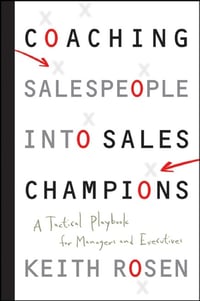
When asked, executive leaders will often agree that sales coaching is valuable and can have a positive impact on their corporate bottom-line.
However, when it comes to action, executive leaders often don’t give coaching the priority that it deserves. In fact, research shows that most firms consider coaching as less of an organizational priority than a management style. Sometimes senior leaders don’t adequately empower sales managers to maximize the productivity of the sales team. Consequently, sales performance never meets its full potential.

When organizations skimp on – or avoid entirely – sales coaching, they jeopardize their business goals. Lack of adequate coaching creates a domino effect: lower sales rep morale leads to higher turnover leads to a decrease in sales and client attrition. This domino effect also affects the sales manager who now must deal with additional workload and stress every time there’s a position vacancy, sales that need to be made, and territories that must be covered.
Now compound these challenges with the other day-to-day responsibilities managers often have. Work hours get stretched and priorities, such as development and sales staff retention, get sacrificed.
Even with the best of intentions, sales managers usually don’t have enough time, resources, and executive support to coach their staff effectively. Managers may also lack the ability to identify and develop the essential skills and core characteristics required to make themselves good coaches.
 Salespeople may interpret a company’s limited coaching and development as a lack of concern on management’s part. Representatives can begin to feel isolated and unsupported. The perception of uncaring and unsupportive leadership can cause anxiety to set in and deteriorate performance further.
Salespeople may interpret a company’s limited coaching and development as a lack of concern on management’s part. Representatives can begin to feel isolated and unsupported. The perception of uncaring and unsupportive leadership can cause anxiety to set in and deteriorate performance further.
Too often today’s sales managers’ spend more time managing processes, data, and problems instead of coaching and developing people. Senior executives would be well served by helping sales managers master coaching and development skills. After all, morale, productivity, and the bottom line suffer when sales coaching isn’t correctly implemented in the sales organization.
Various technological breakthroughs have changed the sales game. The internet, mobile devices, voice-activated search, and beyond now give buyers more power than sales representatives. Buyers can conduct their own research before ever speaking to a salesperson, which means decision makers are more skeptical when engaging with sales reps.
Increasingly, sales agents also find they have limited access to buyers today. Technology allows prospects to screen calls, skip emails and texts, and make purchases online in an attempt to avoid interactions with sales reps altogether.

As the marketplace continues to evolve and technology continues to disrupt how people conduct business, the need for sales coaching increases. Coaching is not just for poor performers; it’s a tool for preparing all of your team members to face new sales challenges and deliver better sales experiences.
A McKinsey Research study uncovered that B2B companies typically average less than 50 percent on a customer-experience index rating. Part of the customer experience is the sales experience delivered by your team. Agents who don’t understand how to engage in insightful dialogue to diagnose buyer problems jeopardize the customer experience from the very beginning. Distrust of sales rep abilities or integrity often results in fewer closed sales. Coaching can help reduce poor customer experiences that occur during the sales cycle.
 Effective sales coaching not only helps managers develop sales reps, but it allows sales managers to improve overall ability to reach or surpass sales goals. Consider this statement from the Sales Management Association, “Firms effective at sales coaching achieve sales objectives 9% higher than other firms, while firms ineffective at coaching suffer rates of sales objective achievement 6% below those of other firms.”
Effective sales coaching not only helps managers develop sales reps, but it allows sales managers to improve overall ability to reach or surpass sales goals. Consider this statement from the Sales Management Association, “Firms effective at sales coaching achieve sales objectives 9% higher than other firms, while firms ineffective at coaching suffer rates of sales objective achievement 6% below those of other firms.”
If you were to ask sales managers about the coaching methods they use, most would respond that they’ve never been formally trained to coach. According to the Sales Management Association’s Sales Coaching Practices Research Brief, 55 percent of firms surveyed say that managers do not know how to coach. This education gap requires support from senior leadership for it to be filled. Unfortunately, 42 percent of respondents say coaching isn’t a priority for senior leadership, 63 percent of organizations don’t hold managers accountable for coaching, and only 50 percent of firms provide training in coaching to managers.

For companies to grow, they must welcome sales coaching as an organizational priority. It’s no longer enough to hope that sales managers embrace coaching as part of their management styles.
For coaching to become an organizational priority rather than merely a discretionary management style, companies must do more than hold a coaching training session. Businesses have to change their cultures, and – as with most culture-shifting initiatives – developing a coaching program requires executive leadership support and buy-in.
 If you are the executive sponsor for the coaching initiative, terrific. If you are someone who needs to secure an executive sponsor, you need to put your sales skills to work with your leadership team to persuade them to invest time and resources in coaching.
If you are the executive sponsor for the coaching initiative, terrific. If you are someone who needs to secure an executive sponsor, you need to put your sales skills to work with your leadership team to persuade them to invest time and resources in coaching.
Once senior leaders are onboard, executives and sales managers should work together to set expectations, define key performance indicators, and tie the coaching program to the company’s vision and business goals. Take time to put these details in writing, and also document:
 While some organizations may have human resources staff members who can help with general coaching development ideas, HR people aren’t salespeople. If you don’t already have a well-established coaching training program, you may want to look beyond your own office for guidance.
While some organizations may have human resources staff members who can help with general coaching development ideas, HR people aren’t salespeople. If you don’t already have a well-established coaching training program, you may want to look beyond your own office for guidance.
Before you hire a consultant, do some research. Talk to colleagues in other companies or industries. Research sales coaching programs online. Check out demos of on-demand training, and read books like Coaching Salespeople into Sales Champions by Keith Rosen (ISBN 978-0-470-1451-6 (cloth) – Publisher Wiley).
After you’ve considered all the training alternatives, work with the leadership team and sales managers to determine which option is likely to deliver the best results and return on investment. Sales Engagement, Simplified 7
 Sales managers don’t have to wait until the end of the quarter to find out how their reps are performing. With immediate access to real-time data, managers can quickly assess group and individual coaching opportunities to turn around performance issues sooner rather than later.
Sales managers don’t have to wait until the end of the quarter to find out how their reps are performing. With immediate access to real-time data, managers can quickly assess group and individual coaching opportunities to turn around performance issues sooner rather than later.
Instead of guessing or assuming where coaching is required, managers using VanillaSoft have the confidence of knowing exactly where and how to focus coaching efforts.
If a sales manager thinks a rep may be experiencing problems, the manager needs to confirm that suspicion first before launching into unneeded one-on-one training. Sometimes that means looking beyond the numbers.
With VanillaSoft, managers can listen in on calls to observe any sales skills issues or review call recordings to perform a quality assurance check before developing any sales coaching plans for a rep.
 With call recordings tied to each contact record, sales managers have the best coaching materials in the world: real examples of calls the rep made.
With call recordings tied to each contact record, sales managers have the best coaching materials in the world: real examples of calls the rep made.
Smart sales managers will use these recordings as conversation starters and allow the sales rep to critique his or her own during the session. If your rep isn’t quickly spotting areas for improvement, play portions of the call and ask probing questions to stimulate the reps’ thinking about the issue(s) you want to address.
Coaching is the most effective when it’s a dialogue, not a monologue.
When you use a system like VanillaSoft, you provide a level playing field for all of your sales reps. They each use the same process, follow the same cadence, and automatically get the next best lead routed to them. They all use the same scripts, email templates, auto dialer, and other tools. With everyone using the same messaging, system and features, your job as coach will be much simpler.
When you can properly diagnose symptoms as system related or rep related, you can make intelligent decisions for addressing challenges. System, process, and messaging issues are yours and marketing’s to resolve. Individual matters – pacing, tone, volume, phone presence – are coaching opportunities.
As mentioned earlier, companies with coaching programs achieve sales objectives at a rate of 9 percent higher than other firms. If that doesn’t convince you that coaching is worthwhile, think about your other sales training investments.
 Studies show that 90 percent of corporate sales training programs only produced a 90-to-120 day increase in sales productivity. After that period, sales productivity returned to pre-training levels. Why? There is typically no ongoing sales coaching to ensure the training sticks. In the United States alone, companies invest $5 billion annually in training. That is a lot of money going to waste when training isn’t reinforced with coaching.
Studies show that 90 percent of corporate sales training programs only produced a 90-to-120 day increase in sales productivity. After that period, sales productivity returned to pre-training levels. Why? There is typically no ongoing sales coaching to ensure the training sticks. In the United States alone, companies invest $5 billion annually in training. That is a lot of money going to waste when training isn’t reinforced with coaching.
While you consider the next steps for reinvigorating or starting a sales coaching program, think about what your sales managers need to help the company and each sales rep achieve better results. Provide executive support, ensure they have appropriate training and coaching themselves, and give them access to technology that helps them deliver the right coaching at the right time to the reps in need.
Training is the most crucial aspect of ramping up sales productivity in any organization. The unfortunate truth is when the training ends, so does the coaching and reinforcement. That's a big problem.
There's an 87% drop off in acquired knowledge when there's a lack of appropriate coaching after sales training.
If you're struggling with this, don't worry...you're not alone! We brought in some sales coaching experts to share their insights when it comes to sales coaching. Listen to what Ashley Gagliano and Steve Burton have to say about how to Coach Your Way to the Close.


I am extremely impressed with how easy it was to get started and train my marketers on the VanillaSoft solution. As well, I had a lot of flexibilityon how I wanted this program to run for our company. Plus, customer service is EXCELLENT at VanillaSoft. I highly recommend VanillaSoft to anyone!

Jody Weinberg J Telecommunications
We have never been so successful. Since we started using VanillaSoft we have increased productivity by 175%! Also, working with the VanillaSoft team has been an incredible experience. They helped us customized our campaigns and page layout to fit our unique needs.

Lauren E. Siegel Hillel Michigan